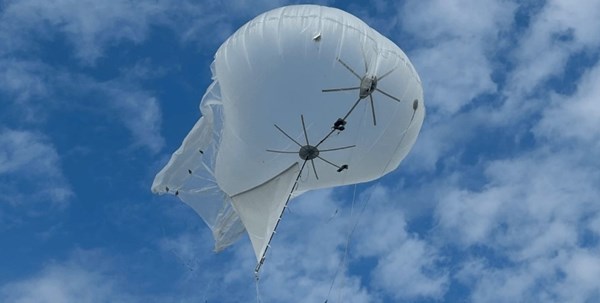Ukrainian company develops versatile surveillance aerostats for military use
The Ukrainian company Aerobavovna has been developing aerostats for the Ukrainian military that can be used for surveillance, relay communication, and drone control signal transmission. Co-founder of the project Yury Visoven told and demonstrated to the Militarny YouTube channel how they work.
Helium-filled aerostats can remain airborne for days or weeks. According to Yury Visoven, the project began with the purchase of British aerostats, but they now manufacture their own. Since its inception, they have produced around one hundred different aerostats. Many technical details have been improved, and certain components had to be custom-made. The current aerostats are significantly different from those just eighteen months prior.
The model Yury demonstrates will be tested for deploying a relay for FPV drones. A relatively small 12 cubic meter aerostat lifts a payload weighing about 4 kg to a height of 500 meters and can stay aloft all day. The relay, controlled by a remote, allows drone operators to switch it on and off as needed, preserving battery life.
"Our very first aerostats resembled plastic bags, the sort everyone has at home in their kitchen. They could fly but weren't suitable for combat conditions," explains Yury Visoven.
The aerostat model engaged in relay testing has already been field-tested on the front lines. Handling it in real-world conditions is well understood, with many enhancements made, particularly to materials. A system has been devised to orientate the relay's antenna in the specific direction of FPV flight. The balloon usually turns against the wind, which can misdirect the relay. Aerobavovna has essentially developed its own FPV relay.
The installed relay can maintain communication over 100 km when 300 meters high. A larger model deploys power supplied via a cable, allowing it to function for two weeks if the battery is replaced or the generator refueled timely. However, this requires a larger balloon, which is more challenging and time-consuming to service. The smaller aerostat Yury showcases can be deployed by a 2-3 person team in 15 minutes. The team is now developing a special trailer to enable launch in just a few minutes.
The balloon's shape is also specifically tailored for operational context:
"The problem is: if you raise and tie a simple balloon, it will be pressed to the ground in strong winds. Therefore, a special aerodynamic shape that combines both a balloon and a kite is essential," says Yury.
A significant portion of the balloon's components is made in Ukraine, with some materials sourced internationally. The balloon's envelope itself is relatively inexpensive compared to the sophisticated systems installed on the aerostat.
Some aerostats have suffered damage from friendly fire on the front lines, when soldiers didn't recognize them for what they were. But a helium-filled aerostat descends gradually, only reaching the ground about three hours after being hit. Consequently, the payload usually remains intact, barring a direct hit.
The Aerobavovna team provides a one-day training course for aerostat operators. The delivery package includes all necessary equipment: the relay, a gimbal for the camera, cylinders for the first refill, a winch, and a repair kit.
Yury says most military personnel are unaware of how aerostats can be utilized. Information on their use is typically highly classified, familiar only to those who have directly observed aerostat operations in other militaries. Demand for aerostats is limited now, but it is expected to increase as experience with their use grows.
"If you recall, 20 years ago, drones were also large and expensive and owned only by Americans, but now everyone is manufacturing them. Somewhere the same will happen with aerostats... There are tasks for which aerostats are better than drones, simply because they can remain airborne for days, not just hours or minutes... We can do a lot here; more importantly, military personnel should come and try to fly it with us at least once to learn the specifics. You can't learn it properly online... And the military can't always come to you, because they have their own tasks. So this takes longer than the actual production," the developer shares.
The Russians are not sitting idly by in this technology either. In September 2023, they reportedly deployed aerostats carrying radar systems to search for Ukrainian drones.
